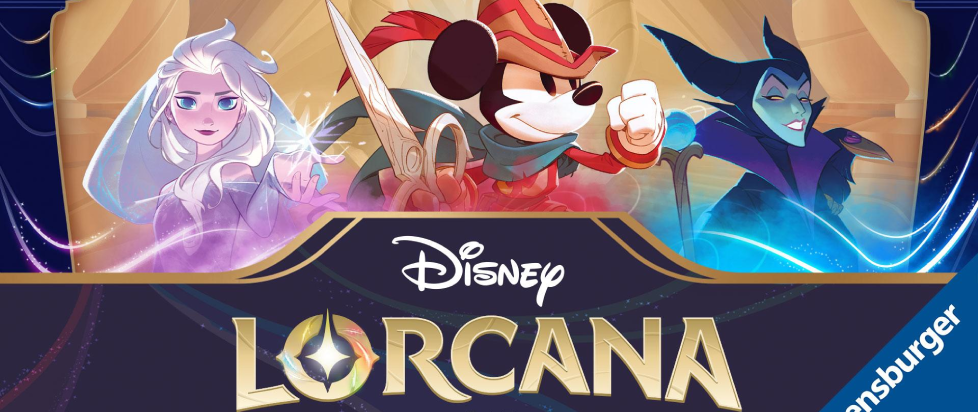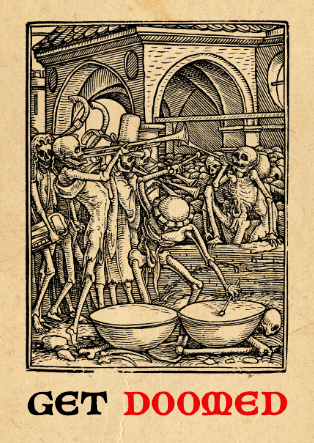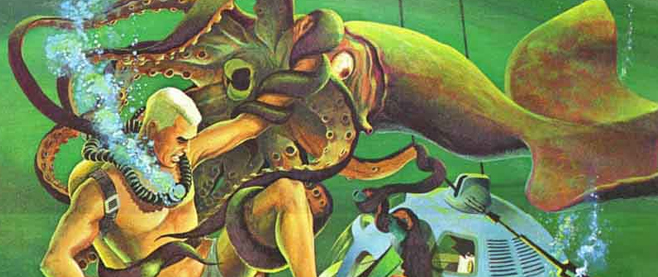
Versus Mode: Lorcana x Sorcerer’s Arena
I see board games in the store and they always look so cool and then I buy them and bring them home, I’m so excited to open them, and then I play them, like, twice…. This column is dedicated to the love of games for those of us whose eyes may be bigger than our stomachs when it comes to playing, and the joy that we can all take from games, even if we don’t play them very often.
———
Is Lorcana a board game?
Not really. For those who have somehow missed the marketing blitz and the furor surrounding its release, Lorcana is a Disney-branded collectible card game, more similar in its execution to Magic or Pokemon than any board game I can call to mind. However, it is manufactured and distributed by Ravensburger, makers of – among other things – the Horrified series of board games, which is enough justification for me to include it here.
I first picked up both Lorcana and Sorcerer’s Arena – the latter released by The Op Games – for similar reasons. Both of them are optimized to play with just two players, and both are Disney-themed, which means that my significant other will already be familiar with the various characters presented therein. And a third reason: Both of them feature Stitch, although in the case of Sorcerer’s Arena, you have to pick up an expansion called Turning the Tide to get him.
While the two games are both played head-to-head, one is definitely more aggressive than the other. One of the most interesting innovations that Lorcana brings to the world of collectible card games is that you are not actively trying to damage or defeat your opponent. Unlike in Magic, for example, where you, the player, have a certain number of hit points that can be whittled away, nothing in Lorcana ever comes for you directly.
Rather than damaging one another or even your various card proxies, the goal of Lorcana is to play characters who can then “quest” for “lore,” the resource that allows you to win the game. Gameplay is simply a race to see who can rack up twenty lore the fastest, and it’s theoretically possible to play a game without ever making a single attack (here called a “challenge”) or otherwise interacting with your opponent in any way – though such a game would probably not be much fun.
Instead, the only reason to “challenge” in Lorcana is to slow your opponent down. By defeating and “banishing” cards from play, you reduce their ability to quest for lore, and therefore buy yourself time to gain more first. A number of simple but ingenious mechanics help to make this more interesting, including that any action a card takes will usually “exert” it (for those familiar with the terminology of Magic, this is equivalent to “tapping” it) and only cards that have exerted can be challenged. Similarly, any challenge deals damage both ways, so you will never escape a challenge unscathed, even if you are the challenger.

It’s a play style that disincentivizes aggression in a way that is at once intriguing and that feels fitting to the ostensibly kid-friendly and cuddlier nature of the game’s theming. Not so with Sorcerer’s Arena, which is a combat game, full stop.
Longtime readers of this column will probably have gathered by now that one of my favorite games is Warhammer Underworlds, even though I’ve never actually written directly about it here. Warhammer Underworlds is a small-scale skirmish game, played with teams of anywhere from three to seven (or, in one case, nine) miniatures on small, hex-covered boards. Aside from rolling dice to complete actions, the randomness of Underworlds comes in the form of decks cards that you draw from each turn to see what kinds of special actions or ploys are available to you.
Sorcerer’s Arena is basically Disney Underworlds. There are differences, of course, but the play styles are extremely similar in many ways, including the hands of cards that affect how you play the game. At the same time, Sorcerer’s Arena is set in a much kinder and gentler world (or worlds) than those of Warhammer, and so there are distinct differences, as well, including that defeated characters are not actually slain but merely KO’ed, to return fully healed at the back part of the board on your next turn.
Because knocking out an enemy character doesn’t last, the ultimate goal of Sorcerer’s Arena is the accrual of victory points, which can be gathered either by occupying certain spaces on the board, or by temporarily taking out enemy fighters. This makes for a much more vicious game than Lorcana, even while the directness of your action can sometimes make the stakes feel ironically less cutthroat.
Unlike Lorcana, Sorcerer’s Arena is not an original game cooked up whole cloth. It is, instead, an adaptation of the mobile game of the same name. I’ve tried out the mobile game a bit, but not enough to really get a feel for it, and there’s something to be said for the joy of pushing little plastic standees around on a board.
When you get right down to it, a lot of the appeal of both Lorcana and Sorcerer’s Arena comes down to their branding. These are Disney games, and part of what makes them fun is the familiarity of the characters, and the easily-digestible artwork that accompanies them. Lorcana offers new takes on classic characters, as well as some interesting examples of translating traits from the source material into game mechanics.
The more straightforward nature of Sorcerer’s Arena allows for fewer clever variations, but it does supply the enjoyment of letting you take hold of a favorite character – assuming you have one, and assuming it is one of the somewhat random characters thus far included in the game – in a new milieu. In the case of Sorcerer’s Arena, these characters are not represented by miniatures but by flat plastic standees, which actually work better for the brand, because they allow the characters to be depicted in two-dimensional drawings, as we’re often used to them.
As of this writing, both games are still in print, and still churning out expansions. Indeed, Lorcana still has a sheen of newness about it, having just launched in 2023. Yet it is also on its third or fourth iteration, known here as “chapters.” New chapters add full suites of additional cards, including characters, actions, items, etc.

Sorcerer’s Arena, on the other hand, primarily adds new characters in its various expansions – and the decisions about who they include are… peculiar. The core game comes with Sorcerer’s Apprentice Mickey, Gaston, Maleficent, Aladdin, Ariel, Sulley, Dr. Facilier, and Demona (from Gargoyles). Weird, right? And the expansions aren’t any less strange.
Each one has a loose theme, and adds three characters. Turning the Tide brings in Stitch, Moana, and Davey Jones. The ostensibly spooky Thrills & Chills adds Jack Skellington, Mother Gothel, and the Horned King from The Black Cauldron. Released in 2023, Leading the Charge lets players choose from Elsa, Buzz Lightyear, and Scar, while the most recent expansion, At the Ready offers Mulan, the Robin Hood that made furries of us all, and, perhaps the weirdest of all the inclusions thus far, the teapot and her kid from Beauty and the Beast.
So, which game wins out? As is ever the case when we do a Versus Mode here at I Played It, Like, Twice, I’m not actually interested in answering that question. Both games do very different things, and they both do them pretty darned well. If you’re a fan of Disney characters or have someone in your household who is, they’re both a solid investment for some one-on-one gaming of your preferred stripe, be that cards, little plastic dudes, or both.
———
Orrin Grey is a writer, editor, game designer, and amateur film scholar who loves to write about monsters, movies, and monster movies. He’s the author of several spooky books, including How to See Ghosts & Other Figments. You can find him online at orringrey.com.




